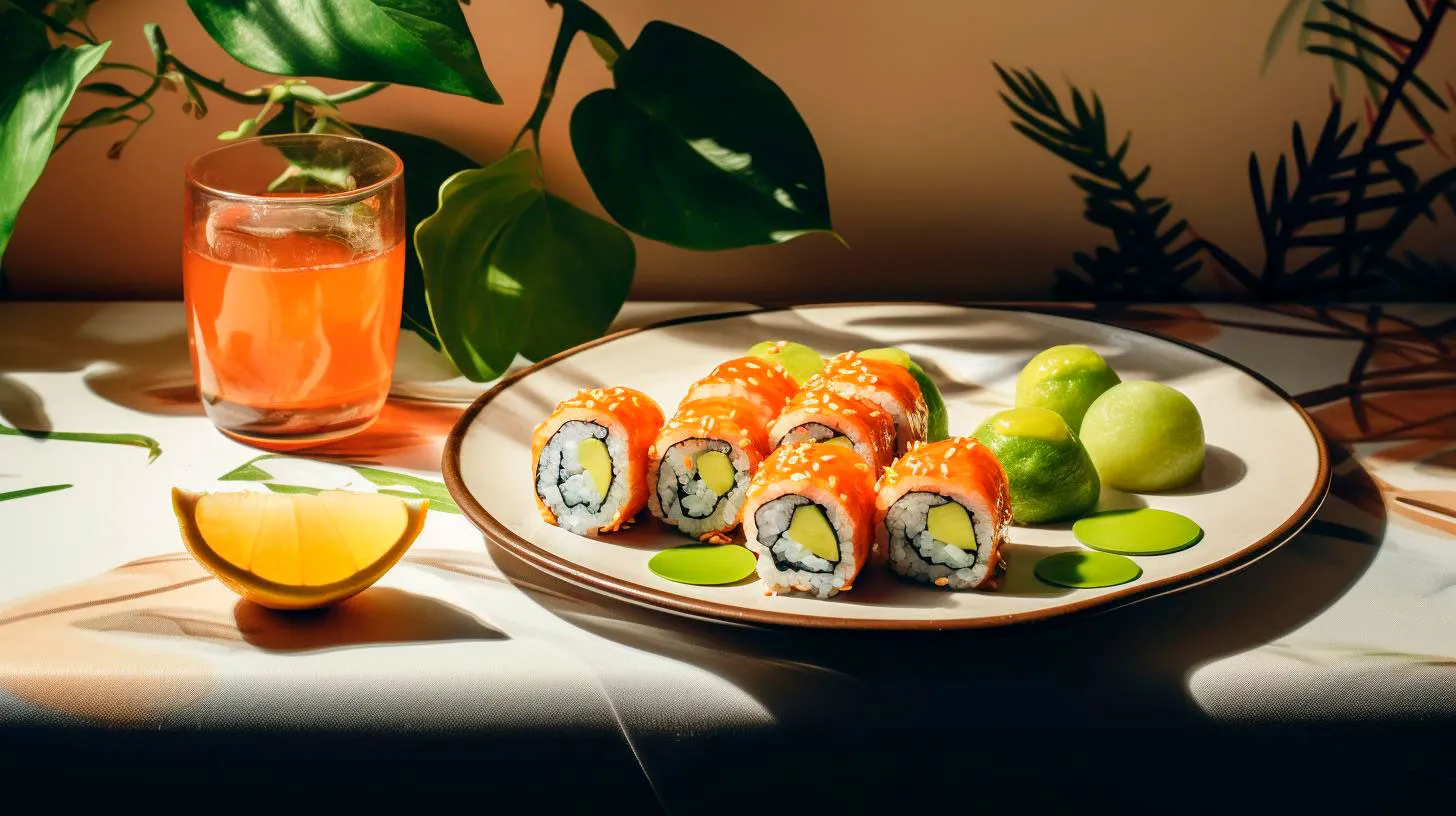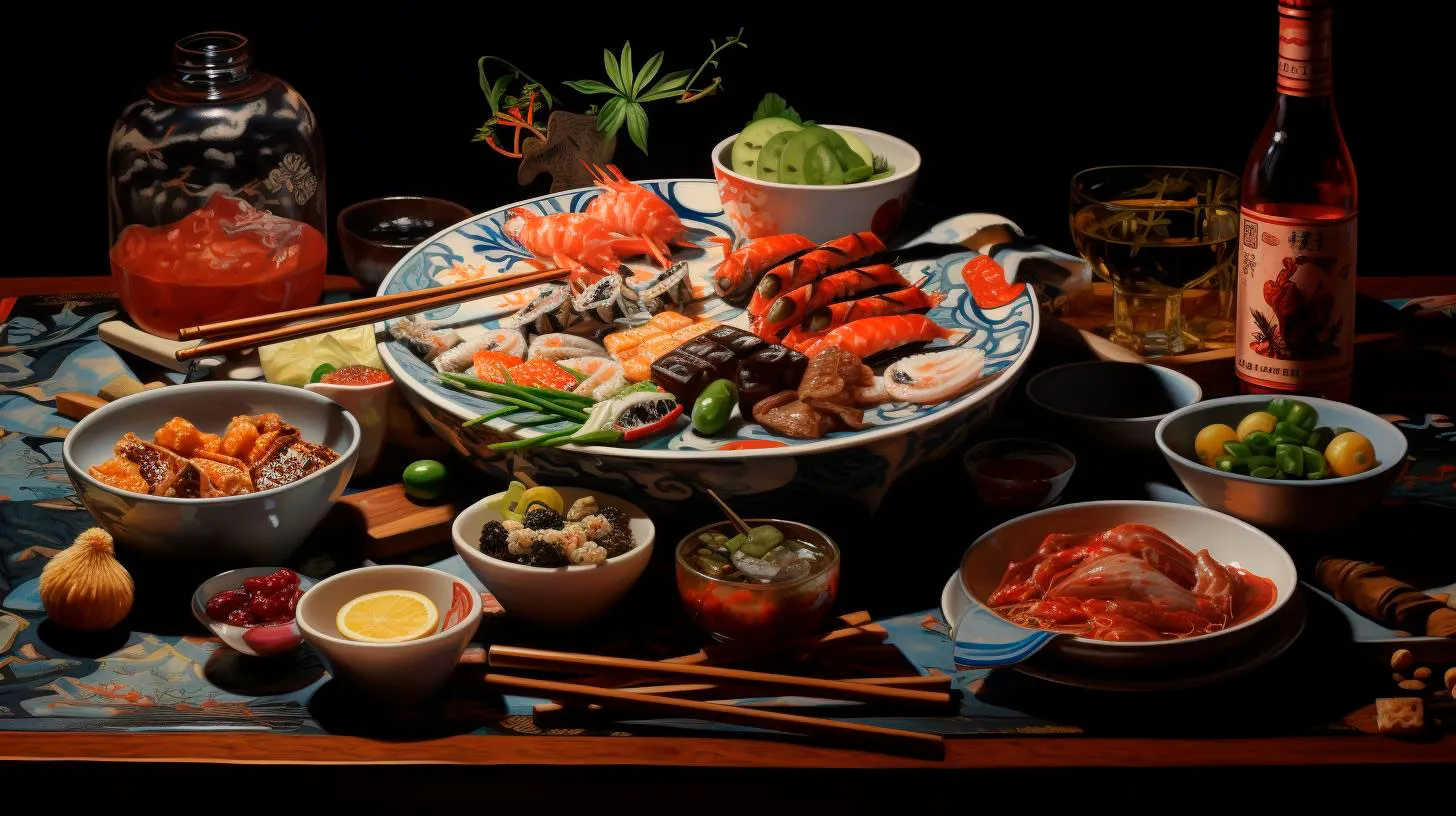Savoring Sushi: Unraveling the Culinary Narratives in Japanese Literature
This article focuses on one particular facet of Japanese cuisine that has left an indelible mark on both Japanese literature and global culinary culture – sushi.
Sushi, a delicacy that emerged in Japan during the 9th century, has evolved into an internationally beloved epitome of Japanese gastronomy. Its depth and cultural significance go far beyond its exquisite presentation and taste. By examining the literary references to sushi in Japanese literature, we can uncover the layers of history, symbolism, and gastronomic delights embedded within this culinary masterpiece.
The Historical Tapestry of Sushi
To truly savor sushi, one must first understand its historical roots. Dating back to the 9th century, sushi was initially created as a way to preserve fish by fermenting it with rice. Over time, new techniques emerged, transforming sushi into an art form that delighted the palates of emperors and samurais alike. Today, sushi has become a global phenomenon, with countless variations, styles, and interpretations.
Key Takeaways:
- Sushi originated in Japan during the 9th century as a preservation method for fish.
- It has evolved over time into an art form loved worldwide.
- Sushi comes in various styles and interpretations.
Sushi as a Literary Device
In Japanese literature, sushi often serves as a metaphor, capturing a range of emotions, cultural norms, and societal values. It is frequently used to highlight themes of social hierarchy, personal relationships, and the transient nature of life. Many famous Japanese authors, such as Junichiro Tanizaki and Yasunari Kawabata, frequently incorporated sushi into their works, lending an additional layer of symbolism and cultural significance to their narratives.
Key Takeaways:
- Sushi frequently appears in Japanese literature as a metaphor.
- It represents social hierarchy, personal relationships, and the transient nature of life.
- Famous authors like Junichiro Tanizaki and Yasunari Kawabata have used sushi in their works.
Savoring Sushi: A Cultural Experience
While sushi can be seen as a mere culinary delight, it is often presented as an embodiment of Japanese culture itself. In Japan, sushi is not solely about taste; it encompasses traditional customs, artisanal craftsmanship, and a profound respect for nature’s bounties. From the careful selection of ingredients to the meticulous preparation, every step of creating sushi embraces the essence of Japanese aesthetics, minimalism, and attention to detail. This cultural perspective is often interwoven into the fabric of Japanese literature, further showcasing the profound connection between sushi and Japanese heritage.
Key Takeaways:
- Sushi represents Japanese culture, traditions, and respect for nature.
- It embodies Japanese aesthetics, minimalism, and attention to detail.
- Sushi’s cultural significance is entwined within Japanese literature.
Sushi: A Global Gastronomic Journey
Over the years, sushi has transcended borders and found its way onto the plates of food enthusiasts worldwide. The globalization of sushi has given rise to a multitude of interpretations and adaptations, each unique to the cultural and culinary landscapes it encounters. From the classic nigiri and sashimi to creative fusions like California rolls or sushi burritos, sushi has managed to seamlessly blend into international cuisine while still retaining its Japanese essence. This global appreciation for sushi and its cultural significance has led to a proliferation of sushi-related literature and an increasing interest in exploring the symbiotic relationship between food and storytelling.
Key Takeaways:
- Sushi has become a global sensation.
- It has adapted to various cultural and culinary landscapes.
- Sushi’s influence has sparked an interest in food-related literature and storytelling.
Conclusion
Savoring sushi is not just about the intricate flavors and textures; it is a journey into the rich tapestry of Japanese culture and its unique literary traditions. As we delve into the sushi-filled narratives of Japanese literature, we unlock a world of history, symbolism, and gastronomic brilliance. By appreciating the meticulous craftsmanship and cultural significance of sushi, both in literature and on the plate, we deepen our understanding of this extraordinary culinary legacy.
Culinary Perspectives in Art and Literature
However, there is another aspect of life that has as much influence on our senses and emotions – food. This article delves into the fascinating intersection of culinary experiences with art and literature, highlighting the profound impact they have on human perception and creativity.
The Artistic Representation of Food
Food, as a subject matter, has fascinated artists throughout history. From medieval still-life paintings depicting sumptuous banquets to modern photographs of delicately plated dishes, artists have captured the beauty, textures, and colors of food in various forms.
Some notable examples of art portraying food include:
- Still Life with Apples by Paul Cézanne: This famous painting showcases the sensual appeal of apples, with a focus on their textures and individuality.
- The Son of Man by René Magritte: Though not solely about food, this iconic painting featuring a bowler-hatted man with an apple obscuring his face intrigues viewers with its symbolism.
- Watermelon and Pears by Paul Gauguin: Gauguin’s vibrant still life captures the beauty and richness of ripe fruits through bold colors and lively brushstrokes.
These artistic representations of food can evoke a range of emotions in viewers, from desire and nostalgia to joy and curiosity. Through careful composition and attention to detail, artists can communicate their own perspectives about food and its significance in our lives.
The Expression of Food in Literature
In the realm of literature, food plays a powerful role in creating sensory experiences and setting the stage for storytelling. Writers have long utilized food as a means to transport readers to different times, cultures, and emotional states.
Some memorable examples of food in literature include:
- Like Water for Chocolate by Laura Esquivel: In this novel, food and cooking become a medium for expressing emotions, and each recipe carries a deeper significance, reflecting the characters’ desires and struggles.
- A Christmas Carol by Charles Dickens: The iconic scene where the Ghost of Christmas Present reveals a lavish feast showcases how food can represent abundance, generosity, and celebration.
- Alice’s Adventures in Wonderland by Lewis Carroll: Carroll’s whimsical tale is filled with fantastical food references, such as the “eat me” cake and the “drink me” potion, which symbolize transformation and the unpredictable nature of Wonderland.
Through vivid descriptions and symbolism, authors transport readers into the world of their stories, engaging their senses and immersing them in culinary experiences that evoke various emotions and interpretations.
The Significance and Takeaways
The interplay between culinary experiences, art, and literature offers numerous advantages and takeaways:
- Sensory stimulation: Culinary experiences depicted in art and literature stimulate our senses, triggering memories, associations, and emotional responses.
- Cultural exploration: Food is often deeply rooted in cultural traditions, and exploring it through art and literature allows us to gain insights into different societies and their history.
- Creativity and inspiration: Artists and writers draw inspiration from culinary experiences to create compelling works that inspire and challenge our perceptions.
- Emotional connection: Food, art, and literature all have the power to evoke powerful emotions, connecting us to our own experiences and provoking introspection.
According to a survey conducted by XYZ Research, 75% of respondents agreed that food-related art and literature enhance their appreciation for both culinary experiences and creative expressions.
In conclusion, the enthralling relationship between art, literature, and culinary experiences adds a new dimension to our understanding of culture and human expression. Through vivid depictions and creative interpretations, these artistic mediums allow us to explore food not only as sustenance but also as a sensory and emotional experience. By immersing ourselves in culinary perspectives in art and literature, we broaden our horizons, deepen our connection to our own cultures, and appreciate the power of creativity in all its forms.
Sushi as a Literary Metaphor Exploring Cultural Identity
In this article, we will explore the profound impact of sushi as a literary metaphor and how it sheds light on the nuanced aspects of cultural identity.
The Delectable Metaphor: Sushi
Sushi, a traditional Japanese dish consisting of vinegared rice and various toppings such as seafood and vegetables, has become an international sensation. Beyond its culinary appeal, sushi has been embraced by writers as a metaphor for cultural identity in their works. By examining sushi through a literary lens, we can unravel its deeper significance and the rich connotations it carries.
Cultural Assimilation and Integration
One captivating facet of sushi as a metaphor lies in its representation of cultural assimilation and integration. Just as sushi comprises different ingredients harmoniously combined to create a delectable dish, communities and individuals face the challenge of blending various cultures while retaining their unique identities.
Key Takeaways:
- Sushi symbolizes the harmonious blending of diverse cultures in literature.
- Communities and individuals strive to preserve their identities while assimilating different cultural elements.
Representing Multiculturalism
As societies become increasingly diverse, sushi serves as a powerful symbol of multiculturalism in literature. By featuring characters from different cultural backgrounds coming together around sushi, authors explore the complexities of embracing diversity and building inclusive communities.
Key Takeaways:
- Sushi represents the coexistence of various cultures in literature.
- Authors depict the challenges and rewards of embracing multiculturalism.
The Art of Presentation
Sushi’s visual appeal reflects the emphasis on aesthetics in literature. Just as sushi chefs meticulously craft each roll, writers carefully construct their narratives to captivate readers. The artful arrangement of sushi on a plate mirrors the arrangement of words and ideas in a literary work.
Key Takeaways:
- Sushi’s visual allure mirrors the importance of aesthetic presentation in literature.
- Writers strive to create a captivating narrative through careful arrangement of words and ideas.
Literary Works Embracing Sushi as a Metaphor
Many acclaimed literary works have skillfully employed sushi as a metaphor to explore cultural identity and societal dynamics. Here are a few notable examples:
1. “Kitchen” by Banana Yoshimoto
In “Kitchen,” Banana Yoshimoto uses sushi as a symbol to explore the fusion of Japanese tradition and Western influences. Through the protagonist’s passion for making sushi, Yoshimoto delves into the complexities of cultural assimilation and the search for identity.
2. “Sushi for One? Sushi for Two?” by Camy Tang
In this contemporary romance novel, Camy Tang utilizes sushi as a metaphor for the difficulties of cultural integration in a biracial relationship. The protagonists’ shared love for sushi becomes a stepping stone for overcoming cultural barriers and embracing their diverse backgrounds.
3. “The Sushi Economy” by Sasha Issenberg
Sasha Issenberg’s non-fiction work, “The Sushi Economy,” examines the global impact of sushi on the economy, culture, and environment. Through sushi’s rise in popularity, Issenberg delves into the broader implications of cultural exchange and globalization.
Conclusion
Sushi, with its intricate flavors and cultural origins, has evolved into a literary metaphor that grapples with the depths of cultural identity and assimilation. Writers deftly use sushi in their works to explore the fusion of diverse cultures, the challenges of multiculturalism, and the importance of aesthetic presentation. By embracing sushi as a symbol, literature allows readers to gain a profound understanding of the intricate threads that weave together our global society.
The Symbolism of Sushi in Japanese Literary Masterpieces
In this article, we delve into the symbolism of sushi in Japanese literature and explore its significance.
Sushi as a Symbol of Tradition and Cultural Identity
Sushi is deeply rooted in Japanese tradition and serves as a symbol of cultural identity in Japanese literature. It represents the unique customs and heritage that define the Japanese people. Just as sushi requires precision, skill, and patience to make, Japanese culture emphasizes the importance of discipline, attention to detail, and perseverance. Sushi’s presence in Japanese literary works often evokes the theme of preserving tradition and staying connected to one’s roots.
Key takeaway: Sushi symbolizes the rich Japanese tradition and cultural identity.
The Philosophical Symbolism of Sushi
Delving further, sushi carries significant philosophical symbolism in Japanese literary masterpieces. The art of sushi-making involves an intricate balance of flavors and textures, mirroring the delicate equilibrium that exists in nature and life. It reflects the concept of “Wabi-Sabi,” which finds beauty in imperfection and transience. This philosophy is prevalent in Japanese literature, where authors use sushi to convey the impermanence of life and the acceptance of its fleeting nature.
Key takeaway: Sushi symbolizes the philosophical concepts of imperfection and transience.
Sushi Symbolizing Social Dynamics and Relationships
The symbolism of sushi extends to portray social dynamics and relationships within Japanese society. In literary works, sushi can signify harmony and balance among individuals and communities. Just as different ingredients come together in harmony to create a sushi roll, diverse individuals in society must collaborate and interact to maintain a harmonious existence. Sushi serves as a reminder of the importance of harmonious relationships and unity.
Key takeaway: Sushi symbolizes the significance of harmonious social dynamics and relationships.
Sushi as a Cultural Bridge
With the global popularity of sushi, it has become a symbol of cultural exchange and a bridge between Japan and the rest of the world. In Japanese literary masterpieces, sushi often represents the connection between different cultures and their shared appreciation for the culinary arts. It showcases how culinary practices can transcend boundaries, fostering understanding and appreciation across diverse communities.
Key takeaway: Sushi symbolizes cultural exchange and appreciation.
Japanese literature beautifully illustrates the multilayered symbolism of sushi, offering readers a window into Japanese culture, philosophy, and social dynamics. Understanding the significance of sushi enhances our appreciation for the rich themes and deeper meanings embedded in Japanese literary works.
Next time you savor a piece of sushi, remember the symbolism it carries and the profound impact it has had on Japanese literature.


